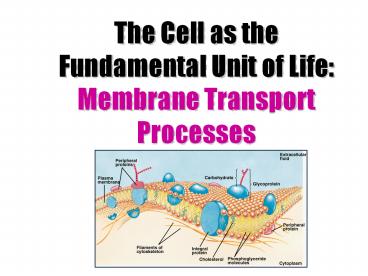The Cell as the Fundamental Unit of Life: Membrane Transport - PowerPoint PPT Presentation
1 / 31
Title:
The Cell as the Fundamental Unit of Life: Membrane Transport
Description:
The Cell as the Fundamental Unit of Life: Membrane Transport Processes Facilitated Diffusion Role of ATP in Energy Metabolism Endocytosis Exocytosis Secretion ... – PowerPoint PPT presentation
Number of Views:253
Avg rating:3.0/5.0
Title: The Cell as the Fundamental Unit of Life: Membrane Transport
1
The Cell as the Fundamental Unit of Life
Membrane Transport Processes
2
Plasma Membrane
Fluid mosaic model
- Working model of the membrane
- Protein molecules bobbing in phospholipid sea
- Proteins determine membranes specific functions
3
Structure of Cell Membrane
Phospholipids
- Most abundant lipid
- Polar/hydrophilic head(attracted to water)
- Pair of nonpolar/hydrophobic tails(repelled by
water)
Hydrophilic head
Hydrophobic tails
4
Phospholipid
5
Phospholipid Bilayer
Polar heads, outside inside Nonpolar tails in
the interior cell membranes
outside
Hydrophilic head
phospholipid
Hydrophobic tail
Hydrophilic head
inside
6
Specializations of the Plasma Membrane
Microvilli- intestinal cells Membrane Junctions
Tight junctions
Desmosomes
Gap junctions
7
Plasma Membrane Function
Selectively permeable- allows certain substances
to pass through By 2 ways active or passive
transport Passive- downhill Active- uphill (needs
energy)
8
Passive Active Transport
- Passive downhill reaction
- Simple diffusion
- Osmosis
- Facilitated diffusion
- Filtration
- Active uphill reaction, needs ATP
- Exocytosis
- Endocytosis
- - Pinocytosis
- - Phagosytosis
9
Passive Diffusion
- No Barrier
- Substances spread out
- High concentration to low concentration
e.g. Red dye placed in glass of water
10
Passive Diffusion
Biological membrane
- Substances diffuse
- High concentration to low concentration
- Pores in membrane must be large
- Down the concentration gradient
- Dynamic equilibrium, equal rates in both
directions
11
Facilitated Diffusion
- Carrier proteins
- Bind specific molecule change shape
- Pass molecule through middle of protein
12
Passive Diffusion
- Osmosis- diffusion of a water through a
semi-permeable membrane
- Moves down concentration gradient
e.g., Two sugar solutions of different
concentrations separated by porous membrane which
lets water through but not sugar
What will happen?
13
Passive Diffusion Terms Osmosis
- More concentrated to less concentrated
- Until concentration same on both sides isotonic
14
Passive Diffusion Terms Osmosis
Concentration of solute less solution is
hypotonic.
Concentration of solute greater solution is
hypertonic.
15
Passive Diffusion
Outcomes to Living Animal Cells
Animal cells No cell walls
Isotonic environment
Influx of water equals the efflux of water
No change in cell shape
16
Passive Diffusion
Outcomes to Living Animal Cells
Hypertonic solution Water leaves cell
Shriveled, or crenate
17
(No Transcript)
18
Passive Transport Filtration
Glomerular filtration
19
Passive Transport and Facilitated Diffusion
Passive transport facilitated diffusion do NOT
require
20
Active Transport
DOES require the input of
outside cell
Transport proteins AGAINST
concentration gradient
inside cell
21
ATP
22
Role of ATP in Energy
Metabolism
ATP ? ADP Pi Energy
23
Endocytosis
24
Exocytosis
25
Secretion
26
Exocytosis
mucus
Goblet cell
http//www.1lecture.com/Physiology/Endocytosis20a
nd20Exocytosis/index.html
27
Membrane Permeability
Cell membrane selectively permeable 4 factors
that determine permeability
lipid solubility molecular size
polarity charge
28
Lipid solubility
Most important factor Hydrophobic molecules
Passively diffuse
Hydrocarbons, carbon dioxide, oxygen
29
Molecular Size and Polarity
Molecular Size
Larger molecules, less permeable
Lower kinetic energy
Small pore
sizes in the membrane
Polarity
Polar molecules hydrophilic, less permeable
Very small, polar
uncharged (water) molecules can diffuse
30
Charge
Charged molecules hydrophilic, less permeable
Surrounded by
coat of water (hydration shell), increases the
size
31
INQUIRY
- What is the main difference between active
transport and facilitate diffusion? - In osmosis, water moves from a xxxx solution to a
xxxx solution. - What happens to blood cells placed in pure water?
- Which portion of the phospholipid molecule faces
the environment outside of the cell? - The release of insulin from certain human cells
is an example of xxxx(endo, exo, phago,
pinocytosis).































